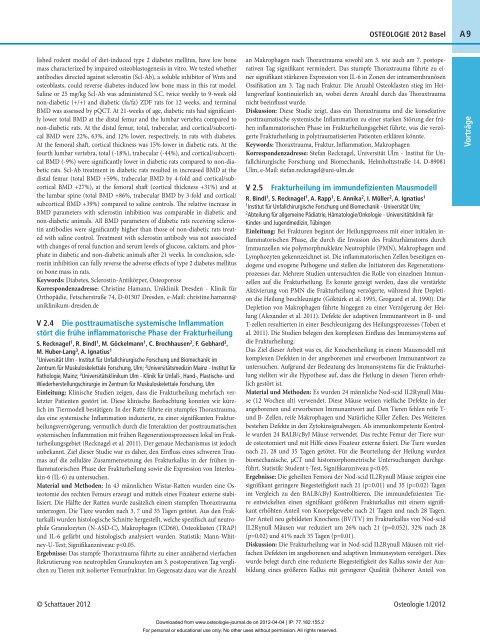Schlüsselwörter - Osteologie Kongress 2012
Schlüsselwörter - Osteologie Kongress 2012
Schlüsselwörter - Osteologie Kongress 2012
Sie wollen auch ein ePaper? Erhöhen Sie die Reichweite Ihrer Titel.
YUMPU macht aus Druck-PDFs automatisch weboptimierte ePaper, die Google liebt.
lished rodent model of diet-induced type 2 diabetes mellitus, have low bone<br />
mass characterized by impaired osteoblastogenesis in vitro. We tested whether<br />
antibodies directed against sclerostin (Scl-Ab), a soluble inhibitor of Wnts and<br />
osteoblasts, could reverse diabetes-induced low bone mass in this rat model.<br />
Saline or 25 mg/kg Scl-Ab was administered S.C. twice weekly to 9-week old<br />
non-diabetic (+/+) and diabetic (fa/fa) ZDF rats for 12 weeks, and terminal<br />
BMD was assessed by pQCT. At 21-weeks of age, diabetic rats had significantly<br />
lower total BMD at the distal femur and the lumbar vertebra compared to<br />
non-diabetic rats. At the distal femur, total, trabecular, and cortical/subcortical<br />
BMD were 22%, 63%, and 12% lower, respectively, in rats with diabetes.<br />
At the femoral shaft, cortical thickness was 15% lower in diabetic rats. At the<br />
fourth lumbar vertebra, total (-18%), trabecular (-44%), and cortical/subcortical<br />
BMD (-9%) were significantly lower in diabetic rats compared to non-diabetic<br />
rats. Scl-Ab treatment in diabetic rats resulted in increased BMD at the<br />
distal femur (total BMD +59%, trabecular BMD by 4-fold and cortical/subcortical<br />
BMD +27%), at the femoral shaft (cortical thickness +31%) and at<br />
the lumbar spine (total BMD +86%, trabecular BMD by 3-fold and cortical/<br />
subcortical BMD +39%) compared to saline controls. The relative increase in<br />
BMD parameters with sclerostin inhibition was comparable in diabetic and<br />
non-diabetic animals. All BMD parameters of diabetic rats receiving sclerostin<br />
antibodies were significantly higher than those of non-diabetic rats treated<br />
with saline control. Treatment with sclerostin antibody was not associated<br />
with changes of renal function and serum levels of glucose, calcium, and phosphate<br />
in diabetic and non-diabetic animals after 21 weeks. In conclusion, sclerostin<br />
inhibition can fully reverse the adverse effects of type 2 diabetes mellitus<br />
on bone mass in rats.<br />
Keywords: Diabetes, Sclerostin-Antikörper, Osteoporose<br />
Korrespondenzadresse: Christine Hamann, Uniklinik Dresden - Klinik für<br />
Orthopädie, Fetscherstraße 74, D-01307 Dresden, e-Mail: christine.hamann@<br />
uniklinikum-dresden.de<br />
V 2.4 Die posttraumatische systemische Inflammation<br />
stört die frühe inflammatorische Phase der Frakturheilung<br />
S. Recknagel1 , R. Bindl1 , M. Göckelmann1 , C. Brochhausen2 , F. Gebhard3 ,<br />
M. Huber-lang3 , A. Ignatius1 1Universität Ulm - Institut für Unfallchirurgische Forschung und Biomechanik im<br />
Zentrum für Muskuloskelettale Forschung, Ulm; 2Universitätsmedizin Mainz - Institut für<br />
Pathologie, Mainz; 3Universitätsklinikum Ulm - Klinik für Unfall-, Hand-, Plastische- und<br />
Wiederherstellungschirurgie im Zentrum für Muskuloskelettale Forschung, Ulm<br />
Einleitung: Klinische Studien zeigen, dass die Frakturheilung mehrfach verletzter<br />
Patienten gestört ist. Diese klinische Beobachtung konnten wir kürzlich<br />
im Tiermodell bestätigen: In der Ratte führte ein stumpfes Thoraxtrauma,<br />
das eine systemische Inflammation induzierte, zu einer signifikanten Frakturheilungsverzögerung,<br />
vermutlich durch die Interaktion der posttraumatischen<br />
systemischen Inflammation mit frühen Regenerationsprozessen lokal im Frakturheilungsgebiet<br />
(Recknagel et al. 2011). Der genaue Mechanismus ist jedoch<br />
unbekannt. Ziel dieser Studie war es daher, den Einfluss eines schweren Traumas<br />
auf die zelluläre Zusammensetzung des Frakturkallus in der frühen inflammatorischen<br />
Phase der Frakturheilung sowie die Expression von Interleukin-6<br />
(IL-6) zu untersuchen.<br />
Material und Methoden: In 43 männlichen Wistar-Ratten wurden eine Osteotomie<br />
des rechten Femurs erzeugt und mittels eines Fixateur externe stabilisiert.<br />
Die Hälfte der Ratten wurde zusätzlich einem stumpfen Thoraxtrauma<br />
unterzogen. Die Tiere wurden nach 3, 7 und 35 Tagen getötet. Aus den Frakturkalli<br />
wurden histologische Schnitte hergestellt, welche spezifisch auf neutrophile<br />
Granulozyten (N-ASD-C), Makrophagen (CD68), Osteoklasten (TRAP)<br />
und IL-6 gefärbt und histologisch analysiert wurden. Statistik: Mann-Whitney-U-Test;<br />
Signifikanzniveau: p


